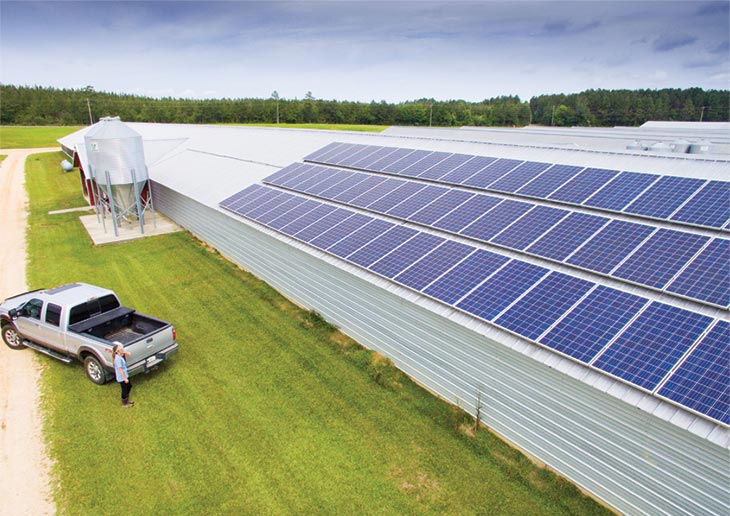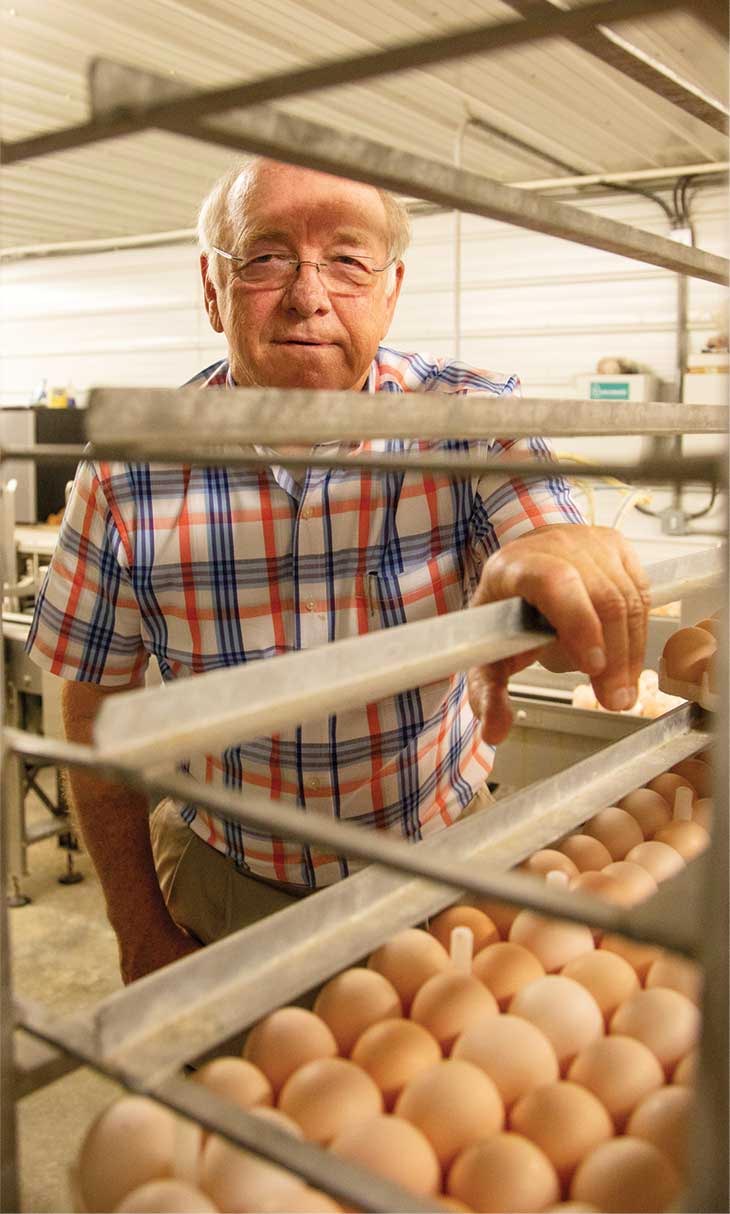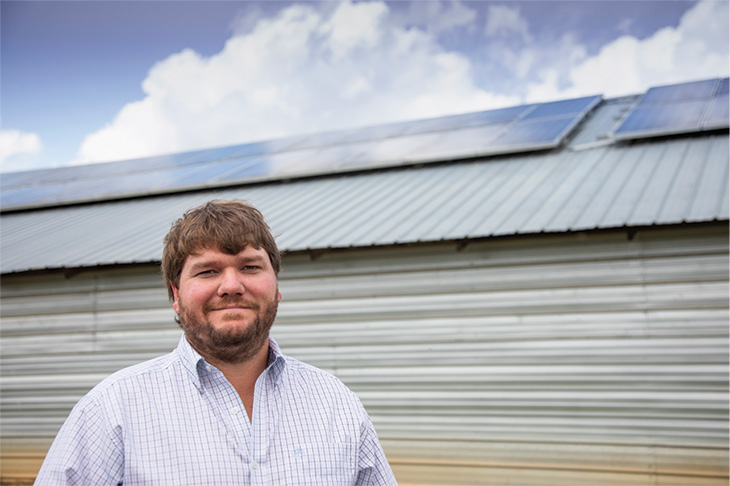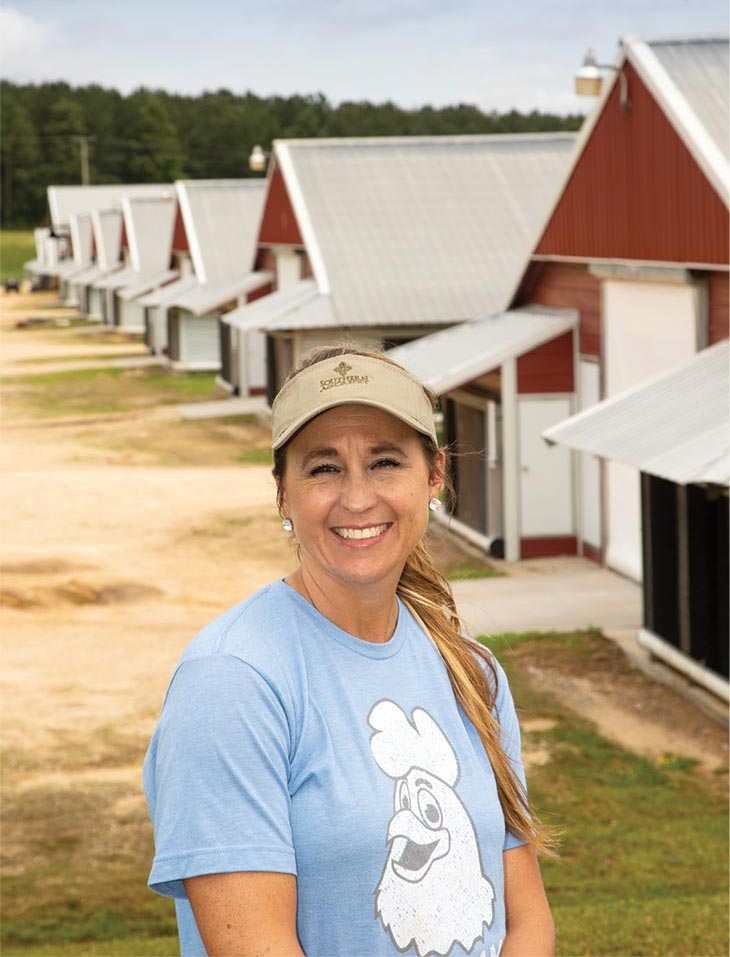
Photo by Debra Ferguson/Southern Images
Installing 600 solar panels and 20 inverters offset nearly 70 percent of the electricity costs at Robin Murry’s poultry operation. Two federal incentive programs covered 55 percent of the cost.
If you could invent a perfect building for solar panels, it might be a poultry house.
The long building is usually oriented east to west, tilting 10,000 square feet of roof toward the sun. Inside, at least a dozen huge fans and up to 100 light bulbs run constantly.
Thus, when three poultry producers near Hattiesburg, Miss., looked at the numbers a few years ago, they saw solar power and energy efficiency as ways to save money.
Southern AgCredit, their lender, supported them.
“Installing solar panels has really helped them … leverage technology to their benefit,” says Brent Barry, regional vice president and branch manager in Hattiesburg. “The poultry industry is all about the bottom line. The more efficient you are, the more profitable you are.”

Photo by Debra Ferguson/Southern Images
Dr. Wallace Carson’s solar energy lowers the cost of powering fans, lights and an automatic egg-gathering system. It also powers a home for his employees.
Cracking High Bills
Veterinary surgeon Dr. Wallace Carson and his wife, Carol, couldn’t pass up a good deal on a foreclosed breeder farm.
Then they saw the electric bills: $28,000 a year to run fans, lights and an automatic egg-gathering system.
After visiting two farms with solar energy, Wallace applied for a USDA Rural Energy for America Program (REAP) grant for 25 percent of a solar project’s cost. He also called Barry, their loan officer.
With financing and the grant approved, the Carsons installed an 82-kilowatt (kW) system — 249 solar panels, and 10 inverters to turn DC power from the panels into AC power. They saved on electricity right away.
“My system should pay for itself in six years, and last 25,” Wallace says.
They also got back 30 percent of the project’s cost from the IRS.
“When I quit dairying, I sold some things that were going to create a significant tax burden,” Wallace says of their previous business. “The tax credit wiped that out real quick.”

Photo by Debra Ferguson/Southern Images
Josh Stringer boosts cash flow by lowering energy bills. He recommends improving insulation, switching to LEDs and installing a solar energy system.
Stacking Up the Savings
Josh and Laura Stringer saw energy efficiency as a quick way to cut expenses at their poultry and stocker cattle operation.
First they replaced the light bulbs in their four broiler houses with LEDs.
“The best way to cash-flow is to save on gas and power,” Josh says. “That’s about the only thing you have control over in the chicken business.”
Later, a contractor offered to install a 60 kW solar energy system for free in exchange for the experience. Once approved for a REAP grant, the panels went up and their bills came down.
"The best way to cash-flow is to save on gas and power. That’s about the only thing you have control over in the chicken business."
– Josh Stringer
Southern AgCredit came on board when the Stringers were ready to build a home.
“I was kind of outgrowing my bank, which wanted to do a mortgage on the house,” Josh says. “Rates were low, and I wanted to refinance. I knew I could bundle the house with the farm (loan) through Southern Ag.
“They’ve been great.”

Photo by Debra Ferguson/Southern Images
Robin Murry manages the broilers on her family’s poultry and cattle operation, where she says the electric bill on 10 poultry houses in summer is “phenomenal.”
Freeing Funds for Other Needs
Mike and Robin Murry have been on the LED bandwagon since 2013, when Sanderson Farms tested the technology at their farm.
“With every flock I would change one house to LEDs,” says Robin, who manages the broilers at their poultry and cattle operation. “The payback was a little over a year.”
Then the couple learned that with a REAP grant and federal tax credit, a solar energy system could pay for itself in about five years. They installed solar panels at the farm and their Hattiesburg store, MS Farm & Garden.
The 160 kW system at the farm was so large, it couldn’t go online until the electric co-op conducted a study. But lower electric bills and extra income were worth the wait.
“You have to be efficient and save money any way you can,” Robin says. “As a farm gets older, repair costs pick up. Saving on electricity lets you utilize that money somewhere else.”
REAP Grants for Two Kinds of Projects
The Mississippi farms all worked with consultant and USDA retiree Bennie Hutchins to write their REAP grant requests.
The grants are available for energy efficiency upgrades and renewable energy systems that reduce operating costs at farms and small rural businesses.
For the biggest return on investment, Hutchins recommends efficient lighting, heating, ventilation and insulation. With renewable energy, he advises sizing the system to produce 65 to75 percent of a farm’s electricity and keeping the payback period under 10 years.
REAP requires $3 of private funds for every $1 in taxpayer funds. That’s where Farm Credit lenders can help.
“The application has to say where the 75 percent match is coming from,” Hutchins says. “We’ve used quite a few Farm Credit System loan commitment letters for these projects.”
– Staff
Ways to Save on Solar
The following incentive programs speed up how quickly a solar energy system pays for itself.
Federal Tax Credits
Commercial solar energy systems qualify for a tax credit of 30 percent of the system’s cost in 2019, 26 percent in 2020, 22 percent in 2021, and 10 percent thereafter. If you can’t use all of the credit in one year, it rolls over.
USDA Rural Energy for America Program (REAP)
Ag producers and rural small businesses may be eligible for grants for 25 percent of the system’s cost.
Depreciation
Businesses can claim accelerated depreciation on federal taxes.
Cash Incentives
Some states, cities and utilities offer other incentives. Learn about programs in your state at www.dsireusa.org.